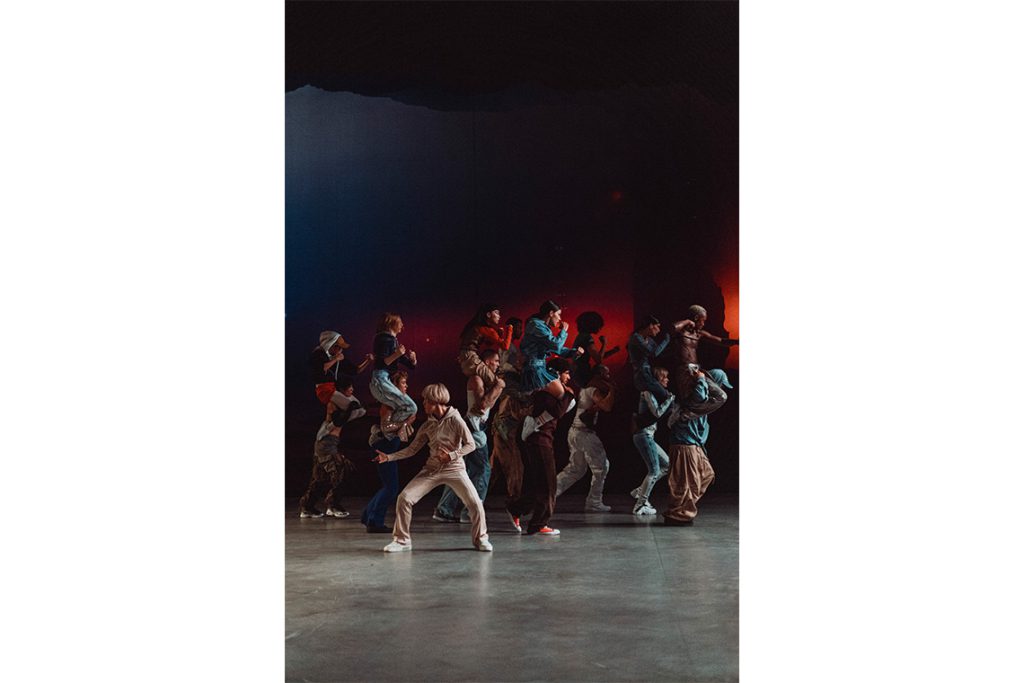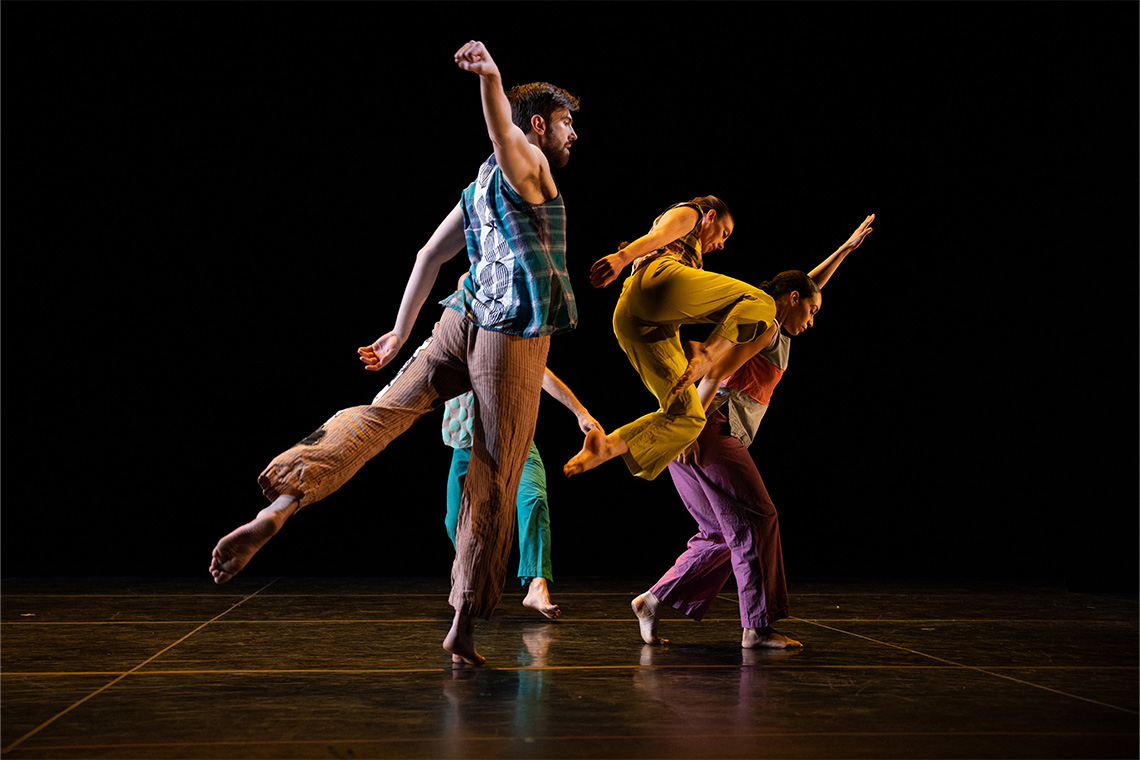The return of Dance Reflections by Van Cleef & Arpels Festival in London showcases the bold and creative visions of choreographers and dancers from across the world of dance.
Dressed in vibrant hues of lilac, yellow and turquoise, dancers leap, roll and extend their arms and legs on stage, their deftly crafted movements creating ethereal visual landscapes, refined in aesthetic and as beautiful to behold as a bejeweled necklace that illuminates the wearer and the surrounding ambiance. The dancers are part of the Trisha Brown Company, and the piece was Working Title (1985), one of the iconic works of the late American choreographer whose compositions are characterised by their ability to push the limits of the dancers’ athleticism and stamina while offering graceful and poignant movements and expression. The work was performed at London’s Sadler’s Wells Theatre as part of the second edition in the British capital of Dance Reflections by Van Cleef & Arpels, a four-week celebration (12 March to 8 April) taking place at four partner organisations: Sadler’s Wells Theatre, The Royal Ballet and Opera, Tate Modern and, for the first time, the Southbank Centre.
Dance has long been part of the Van Cleef & Arpels heritage. The art of ballet, its graceful flair and sense of enchantment, has for decades served as inspiration for the Maison’s jewellery creations. The innate connection with dance then led Van Cleef & Arpels to several collaborations with dancers and choreographers themselves. Legendary choreographer George Balanchine’s dazzling masterpiece Jewels, created in 1967, was inspired by a serendipitous visit to the Maison on Fifth Avenue. In 2007, Van Cleef & Arpels supported the Royal Ballet and Opera for a special performance of Jewels, considered the first full-length abstract ballet and then celebrating its 40th anniversary. Today, the Maison has ongoing partnerships with several major ballet companies, including Boston Ballet and the Australian Ballet, as well as with contemporary dance companies such as Benjamin Millepied’s LA Dance Project. In 2020, it inaugurated Dance Reflections, a roving festival, and held the first London edition in 2022. Iterations have been staged since in Los Angeles and Kyoto. Dance Reflections also supported The Arts Center at NYU Abu Dhabi for the presentation of three shows for the 2024–25 season and the Maison hopes to do more in the Middle East.
Meanwhile, past and present intertwine in myriad ways. “I don’t have a past,” noted Balanchine in 1904. “I have a continuous present. The past is part of the present, just as the future is. We exist in time.” It is challenging to understand how such an ephemeral art form could exist in time – performance is fleeting, while a piece of jewellery is a material object that serves as a lasting work of art. And yet, in much the same spirit as Balanchine, Van Cleef & Arpels believes in the permanence and importance of a performance, both metaphysically and literally, and in its ever-present impact and inspiration. “The festival is a way to continuously celebrate something,” says Serge Laurent, the Maison’s dance and cultural program manager, previously head of live performance programming at the Centre Pompidou. “The best way to explain the mystery of contemporary dance and contemporary art is to connect it to history and present how a contemporary dance piece, like a work of contemporary art, is the result of an evolution. It reflects how art history has evolved through the ages.”

Staging the festival in London, in both its inaugural edition and the present iteration, has ignited new conservations between dance, jewellery and cultures, especially in terms of how art can represent movement and why the latter is so important to art and to human intellectual and physical wellbeing. At the end of 2022, the Maison staged The Art of Movement exhibition at London’s Design Museum, unveiling works from its patrimonial collection, including pieces that showcase female figures performing entrechats and graceful leaps through the air. As Catherine Renier, CEO and President of the Maison stated in her speech during the opening gala dinner for the festival, the second Dance Reflections in London offers “an opportunity to explore new aspects of our heritage.”
The festival opened powerfully with performances on the first two nights that showcased the rich variety of contemporary dance. Christian Rizzo’s Sakinan Göze Çöp Batar (An Over-protected Eye Always Gets Sand in It) is inspired by a traditional Turkish dance and the result of a collaboration with the dancer Kerem Gelebek, who presented a solo performance against the backdrop of an artistic mise-en-scène reflecting that of a contemporary work of art. The poignant performance concentrated on the themes of melancholy and exile – not necessarily confined to a territory, but extending to the individual during an age of great technological change.
Rizzo’s performance was followed by two works performed by the Trisha Brown Dance Company. In the Fall, a worked created in 2023 by French choreographer Noé Soulier, marked the company’s second-ever special commission and revealed dancers quickly moving across the stage in a series of fast, elongated and enrapturing moves. It was presented alongside Working Title, an iconic piece choreographed by Brown in 1985. The two works highlighted the breadth and depth of the company, as well as the festival’s dedication to preserving historical works while also championing new choreographic creations.
Pivotal to the festival, explains Jamie Scott, programing director of the Trisha Brown Dance Company (where she danced during 2012–17), is “the transmission and legacy of creative education and preservation of these iconic works”. This is being achieved, she says, “through the creation of new work, as well as educational programmes and licensing programmes devised around them. Dance Reflections has also supported our revivals of older works, which is something that is hard to find funding for in the United States and beyond.”
Laurent believes that what is important now is to present “the diversity of dance – how it is rich and varied in terms of artistry and aesthetic, and how a contemporary artist can be part of this history.” He sees the role of artists as crucial. “For me, they are researchers, they are inventing languages,” he adds. “In art history we look to the past, to the artists who took risks and who were at first misunderstood”. He notes how, when legendary Russian ballet dancer and choreographer Vaslav Nijinsky first presented the ballet The Rite of Spring to the orchestral work of Igor Stravinsky, it was a scandal. “The same goes for Pina Bausch during the 1980s. People didn’t like it.” Today, Bausch’s neo-expressionist approach to dance is highly appreciated, underlining Laurent’s belief that “it is very important to support these kinds of artists”.
A particularly edgy yet hugely popular and gripping piece was presented on the second day of the festival: Age of Content by the collective (LA)HORDE in collaboration with dancers of the Ballet National de Marseille. The impactful choreography merged the worlds of contemporary art, technology and design in a performance that reflected the influence of action films, video games, AI and musicals in a bold, provocative and fun creation that served as a nod to the chaotic landscape of our digital and real lives today. “Like with contemporary art, we are asking people to be open to new experiences,” adds Laurent. “I found that to use the entry of history is the best way to approach contemporary art.”
Dance Reflections runs until 8 April



